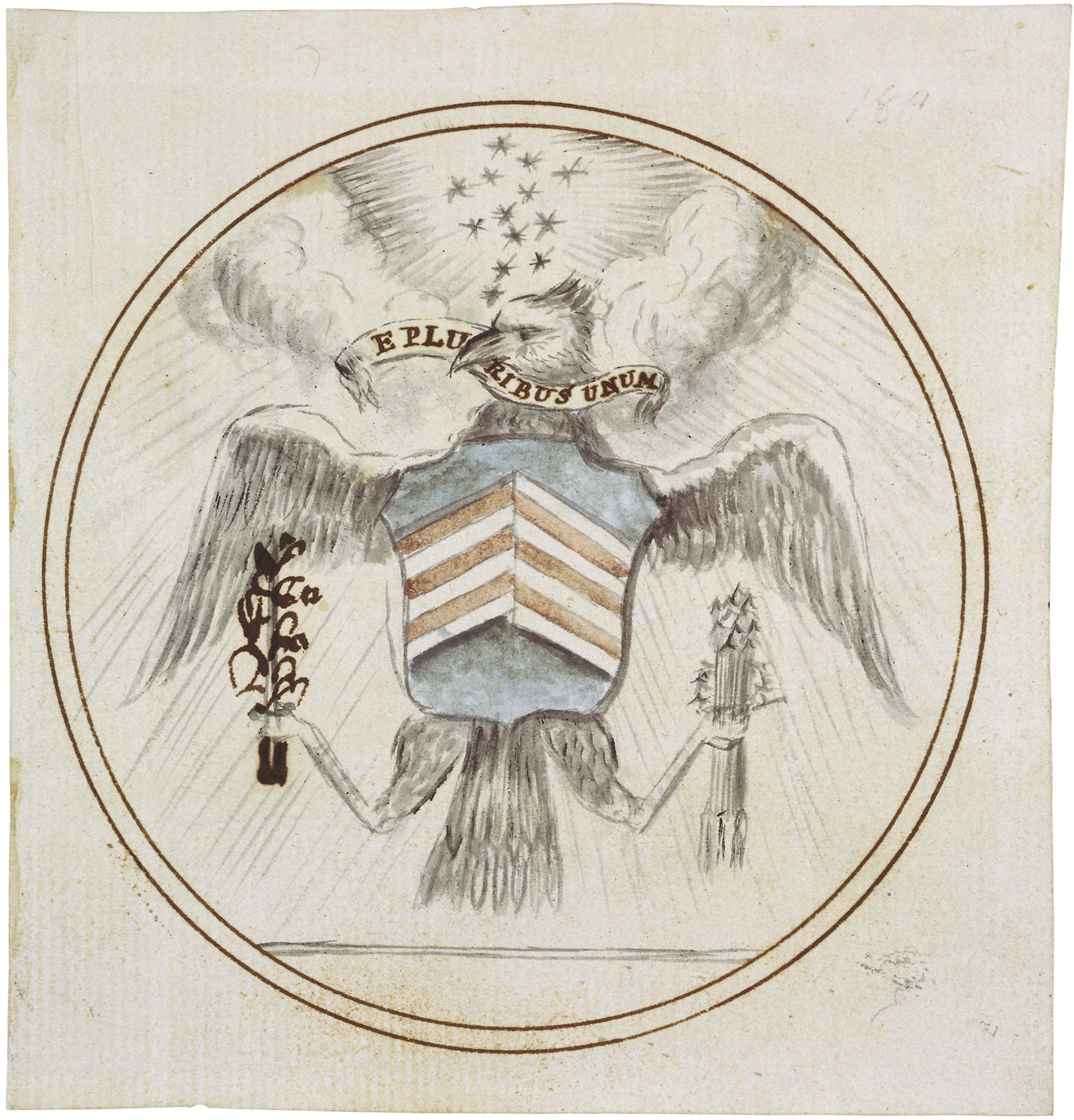Design for the Verso of the Great Seal of the United States
1782
Add to Favorites:
Add all page(s) of this document to activity:

Just a few hours after the Declaration of Independence was adopted by the Continental Congress on July 4, 1776, the first committee to design a seal for the United States was appointed, and its design began.
The committee members—Benjamin Franklin, Thomas Jefferson, and John Adams—prepared a very complicated design that was promptly tabled by Congress. However, one prominent feature of their design appeared in the design that was originally adopted—the motto E Pluribus Unum, "Out of Many, One."
In 1780, a second committee—James Lovell of Massachusetts and John Morin Scott and William Churchill Houston of Virginia—developed a second design, but it was also tabled by Congress. Like the first design, the second had elements that were later incorporated into the final seal, including the olive branch, the constellation of 13 stars, and the shield with red and white stripes on a blue field.
A third committee was appointed in May of 1782. This committee's design employed the eagle for the first time, in the crest.
Early in 1782, Congress referred the three designs to Secretary of the Continental Congress Charles Thomson. Thomson combined elements of all three previous attempts to make a fourth design. He made the eagle the focal point with its wings pointed down as if in flight. The shield on the eagle’s breast was blue with 13 red and white chevrons pointing up. His design was revised by William Barton, a Philadelphia student of heraldry, to create the current design.
Thomson submitted a written description of his final version to the Continental Congress that described the design and explained its symbolism. The Continental Congress approved and officially adopted this design on June 20, 1782.
The Great Seal of the United States is the symbol of our sovereignty as a nation. Its obverse is used on official documents to authenticate the signature of the President; and it appears on proclamations, warrants, treaties, and commissions of high officials of the government. The Great Seal's design, used as our national coat of arms, is also used officially as decoration on military uniform buttons, on plaques above the entrances to U.S. embassies an consulates, and in other places. Both the obverse and the less familiar reverse, which is never used as a seal, are imprinted on the one-dollar bill.
This document was featured in “Teaching with Documents : OurDocuments.gov” in the November/December 2002 National Council for the Social Studies (NCSS) publication Social Education.
The committee members—Benjamin Franklin, Thomas Jefferson, and John Adams—prepared a very complicated design that was promptly tabled by Congress. However, one prominent feature of their design appeared in the design that was originally adopted—the motto E Pluribus Unum, "Out of Many, One."
In 1780, a second committee—James Lovell of Massachusetts and John Morin Scott and William Churchill Houston of Virginia—developed a second design, but it was also tabled by Congress. Like the first design, the second had elements that were later incorporated into the final seal, including the olive branch, the constellation of 13 stars, and the shield with red and white stripes on a blue field.
A third committee was appointed in May of 1782. This committee's design employed the eagle for the first time, in the crest.
Early in 1782, Congress referred the three designs to Secretary of the Continental Congress Charles Thomson. Thomson combined elements of all three previous attempts to make a fourth design. He made the eagle the focal point with its wings pointed down as if in flight. The shield on the eagle’s breast was blue with 13 red and white chevrons pointing up. His design was revised by William Barton, a Philadelphia student of heraldry, to create the current design.
Thomson submitted a written description of his final version to the Continental Congress that described the design and explained its symbolism. The Continental Congress approved and officially adopted this design on June 20, 1782.
The Great Seal of the United States is the symbol of our sovereignty as a nation. Its obverse is used on official documents to authenticate the signature of the President; and it appears on proclamations, warrants, treaties, and commissions of high officials of the government. The Great Seal's design, used as our national coat of arms, is also used officially as decoration on military uniform buttons, on plaques above the entrances to U.S. embassies an consulates, and in other places. Both the obverse and the less familiar reverse, which is never used as a seal, are imprinted on the one-dollar bill.
This document was featured in “Teaching with Documents : OurDocuments.gov” in the November/December 2002 National Council for the Social Studies (NCSS) publication Social Education.
This primary source comes from the Records of the Continental and Confederation Congresses and the Constitutional Convention.
National Archives Identifier: 595257
Full Citation: Design for the Verso of the Great Seal of the United States; 1782; Reports on Administrative Affairs of the Congress; Papers of the Continental Congress, 1774 - 1789; Records of the Continental and Confederation Congresses and the Constitutional Convention, Record Group 360; National Archives Building, Washington, DC. [Online Version, https://docsteach.org/documents/document/design-verso-great-seal, April 19, 2024]Activities that use this document
- Finding American Symbols
Created by the National Archives Education Team - Monumentos Nacionales Expresan Valores Nacionales
Created by the National Archives Education Team - National Monuments Express National Values
Created by the National Archives Education Team
Rights: Public Domain, Free of Known Copyright Restrictions. Learn more on our privacy and legal page.



